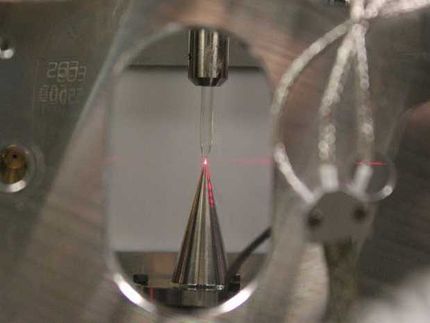The world's shortest laser pulse
Observe the movement of electrons during chemical reactions in slow motion
Advertisement
ETH researchers succeeded in shortening the pulse duration of an X‑ray laser to only 43 attoseconds. With a time resolution in the range of a few quintillionths of a second, they are now able for the first time to observe the movement of electrons during chemical reactions in slow motion.

Thomas Gaumnitz, postdoctoral fellow in the group of ETH professor Hans Jakob Wörner with the setup that generates the shortest laser pulses in the world.
ETH Zürich
In order to fully understand the dynamics during a chemical reaction, scientists must be able to study all movements of atoms and molecules on their basic time scale.
Molecules rotate in the range of picoseconds (10-12 s), their atoms vibrate in the range of femtoseconds (10‑15 s), and the electrons move in the range of attoseconds (10-18 s). ETH professor Hans Jakob Wörner and his group have now succeeded in generating the world's shortest laser pulse with a duration of only 43 attoseconds. More generally speaking, this laser pulse is the shortest controlled event that has ever been created by humans. The researchers can now observe in high detail how electrons move within a molecule or how chemical bonds are formed.
Breaking down transition states
Starting from an infrared laser, the researchers generate a soft X-ray laser pulse with a very large spectral bandwidth. As a result, various elements including phosphorus and sulphur can be directly observed by exciting their inner-shell electrons. Both elements are present in biomolecules, and it is now possible to observe them with unprecedented time resolution.
But what is the advantage of being able to observe the reaction steps now with even higher resolution? "The faster a charge transfer can take place, the more efficiently a reaction can proceed", says Prof. Wörner. The human eye for example is very efficient when it comes to converting photons into nerve signals. In rhodopsin, a visual pigment in the retina, the photosensitive molecule retinal is prearranged in such a way that its structure can change extremely fast through the absorption of only a single photon. This enables the visual process even in twilight. A much slower reaction would render vision impossible, because the energy of the photon would be converted to heat in only a few picoseconds.
Attosecond spectroscopy could contribute to the development of more efficient solar cells since it is now for the first time possible to follow the process of excitation through sunlight up to the generation of electricity step by step. A detailed understanding of the charge transfer pathway could help optimizing the efficiency of the next generation of photosensitive elements.
Optical manipulation of the reaction process
Attosecond laser spectroscopy is not only suitable for mere observation, Prof. Wörner explains. Chemical reactions can also be directly manipulated: Using a laser pulse can alter the course of a reaction – even chemical bonds can be broken by stopping the charge shift at a certain location in the molecule. Such targeted interventions in chemical reactions have not been possible until now, since the time scale of electron movement in molecules was previously unreached.
The group of Prof. Wörner is already working on the next generation of even shorter laser pulses. These will make it possible to record even more detailed images, and thanks to a wider X-ray spectrum even more elements can be probed than before. Soon it will be possible to follow the migration of electrons in more complex molecules with an even higher time resolution.
Original publication
Other news from the department science
Most read news
More news from our other portals
See the theme worlds for related content
Topic World Spectroscopy
Investigation with spectroscopy gives us unique insights into the composition and structure of materials. From UV-Vis spectroscopy to infrared and Raman spectroscopy to fluorescence and atomic absorption spectroscopy, spectroscopy offers us a wide range of analytical techniques to precisely characterize substances. Immerse yourself in the fascinating world of spectroscopy!

Topic World Spectroscopy
Investigation with spectroscopy gives us unique insights into the composition and structure of materials. From UV-Vis spectroscopy to infrared and Raman spectroscopy to fluorescence and atomic absorption spectroscopy, spectroscopy offers us a wide range of analytical techniques to precisely characterize substances. Immerse yourself in the fascinating world of spectroscopy!
























































